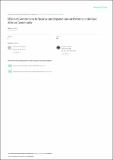| dc.contributor.author | Phoebe Mshai Mwasagua, Alphonce Juma Odondo, Destaings Nyongesa | |
| dc.date.accessioned | 2022-01-23T08:52:37Z | |
| dc.date.available | 2022-01-23T08:52:37Z | |
| dc.date.issued | 2021 | |
| dc.identifier.issn | 2519-9730 | |
| dc.identifier.uri | https://repository.maseno.ac.ke/handle/123456789/4558 | |
| dc.description.abstract | The East African Community (EAC) level of economic integration is among the most advanced
Regional Economic Communities (RECs) in Africa. With advancement in integration, efforts are being made by the
member countries to have collective decision making on fiscal policies with the view of addressing poverty situation
among other economic factors. However, while economic theory indicates that increased government expenditure
leads to reduced poverty, empirical literature pits conflicting results. The difference in opinions poses lack of
predictability of public finance decision making as to whether a perceptible relationship exists between public
expenditure on infrastructure and poverty. This study thus, assessed the effect of government expenditure on
infrastructure and poverty in EAC. Poverty was measured by private consumption per capita. The study was
anchored on the Ferroni and Kaburi resource allocation framework. Correlational research design was adopted in the
study. The analysis span between 2007 and 2018. The study used data drawn from five countries, namely, Burundi,
Kenya, Rwanda, Tanzania and Uganda. Panel data analysis was employed to interrogate the study topic. The
Random Effects Model was used to estimate the relationship after converting the log transformed data to stationary
series. The results indicated that Government expenditure on infrastructure was significant in lowering poverty
(β2=0.1577; p=0.0000). Thus, the need to enhance allocation and expenditure on infrastructure to arrest poverty. The
findings may be beneficial to policymakers, strategists, government and advocacy groups | en_US |
| dc.description.abstract | The East African Community (EAC) level of economic integration is among the most advanced
Regional Economic Communities (RECs) in Africa. With advancement in integration, efforts are being made by the
member countries to have collective decision making on fiscal policies with the view of addressing poverty situation
among other economic factors. However, while economic theory indicates that increased government expenditure
leads to reduced poverty, empirical literature pits conflicting results. The difference in opinions poses lack of
predictability of public finance decision making as to whether a perceptible relationship exists between public
expenditure on infrastructure and poverty. This study thus, assessed the effect of government expenditure on
infrastructure and poverty in EAC. Poverty was measured by private consumption per capita. The study was
anchored on the Ferroni and Kaburi resource allocation framework. Correlational research design was adopted in the
study. The analysis span between 2007 and 2018. The study used data drawn from five countries, namely, Burundi,
Kenya, Rwanda, Tanzania and Uganda. Panel data analysis was employed to interrogate the study topic. The
Random Effects Model was used to estimate the relationship after converting the log transformed data to stationary
series. The results indicated that Government expenditure on infrastructure was significant in lowering poverty
(β2=0.1577; p=0.0000). Thus, the need to enhance allocation and expenditure on infrastructure to arrest poverty. The
findings may be beneficial to policymakers, strategists, government and advocacy groups | en_US |
| dc.publisher | Noble International Journal of Economics and Financial Research | en_US |
| dc.subject | Government expenditure, Infrastructure, Economic Integration, FK framework, Panel, Poverty, East African Community. | en_US |
| dc.subject | Government expenditure, Infrastructure, Economic Integration, FK framework, Panel, Poverty, East African Community. | en_US |
| dc.title | Effect of Government Infrastructure Expenditure on Poverty in the East African Community | en_US |
| dc.type | Article | en_US |

